Pedagogy for Positive Learning Environments
VerifiedAdded on 2023/06/11
|5
|1365
|241
AI Summary
This reflective essay discusses the importance of positive learning environments and managing challenging students. It emphasizes the role of both teachers and students in creating a healthy atmosphere for learning. The essay also explores the use of punishment and reinforcement methods to shape student behavior. Subject: Education, Course Code: N/A, Course Name: N/A, College/University: N/A
Contribute Materials
Your contribution can guide someone’s learning journey. Share your
documents today.
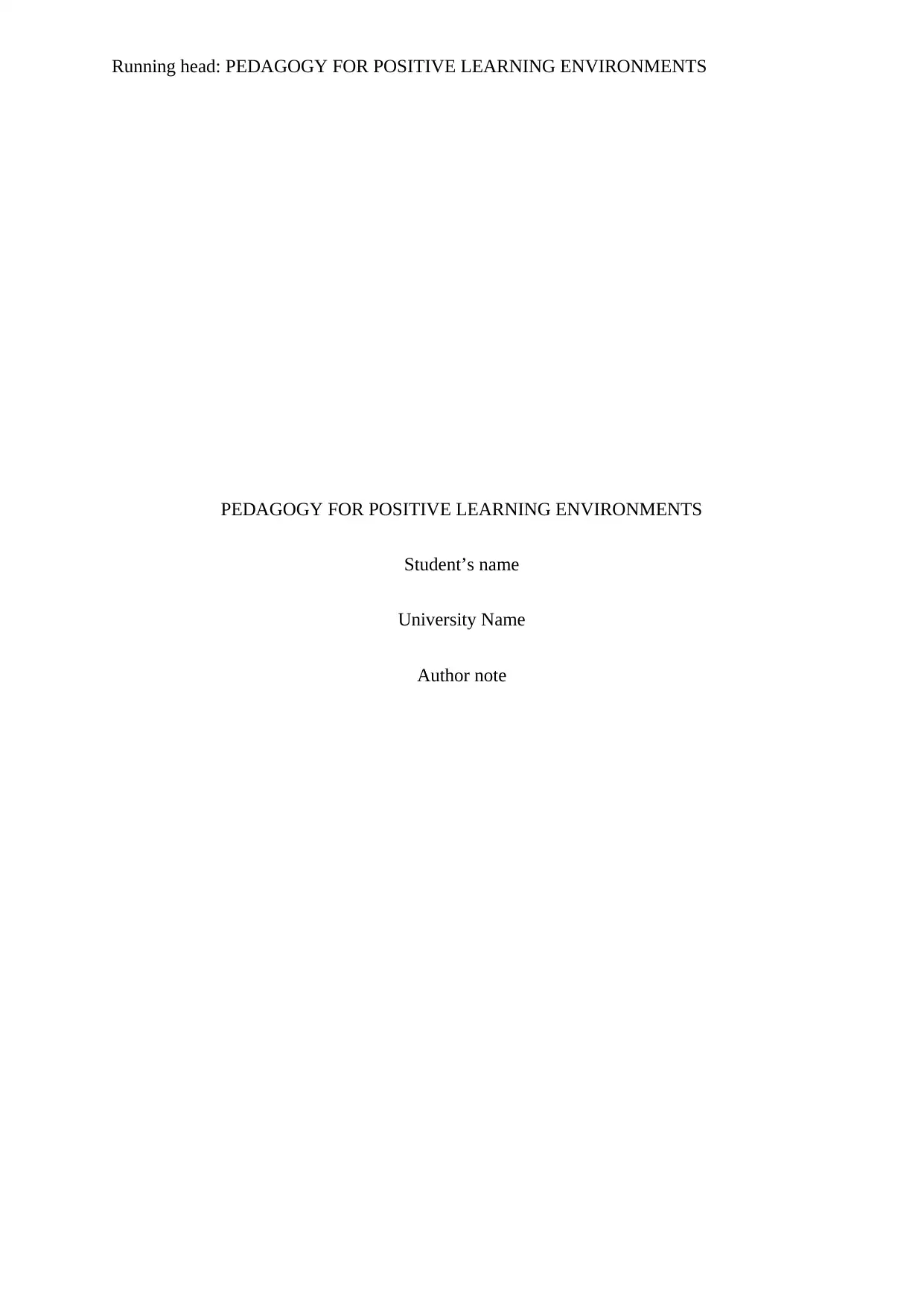
Running head: PEDAGOGY FOR POSITIVE LEARNING ENVIRONMENTS
PEDAGOGY FOR POSITIVE LEARNING ENVIRONMENTS
Student’s name
University Name
Author note
PEDAGOGY FOR POSITIVE LEARNING ENVIRONMENTS
Student’s name
University Name
Author note
Secure Best Marks with AI Grader
Need help grading? Try our AI Grader for instant feedback on your assignments.
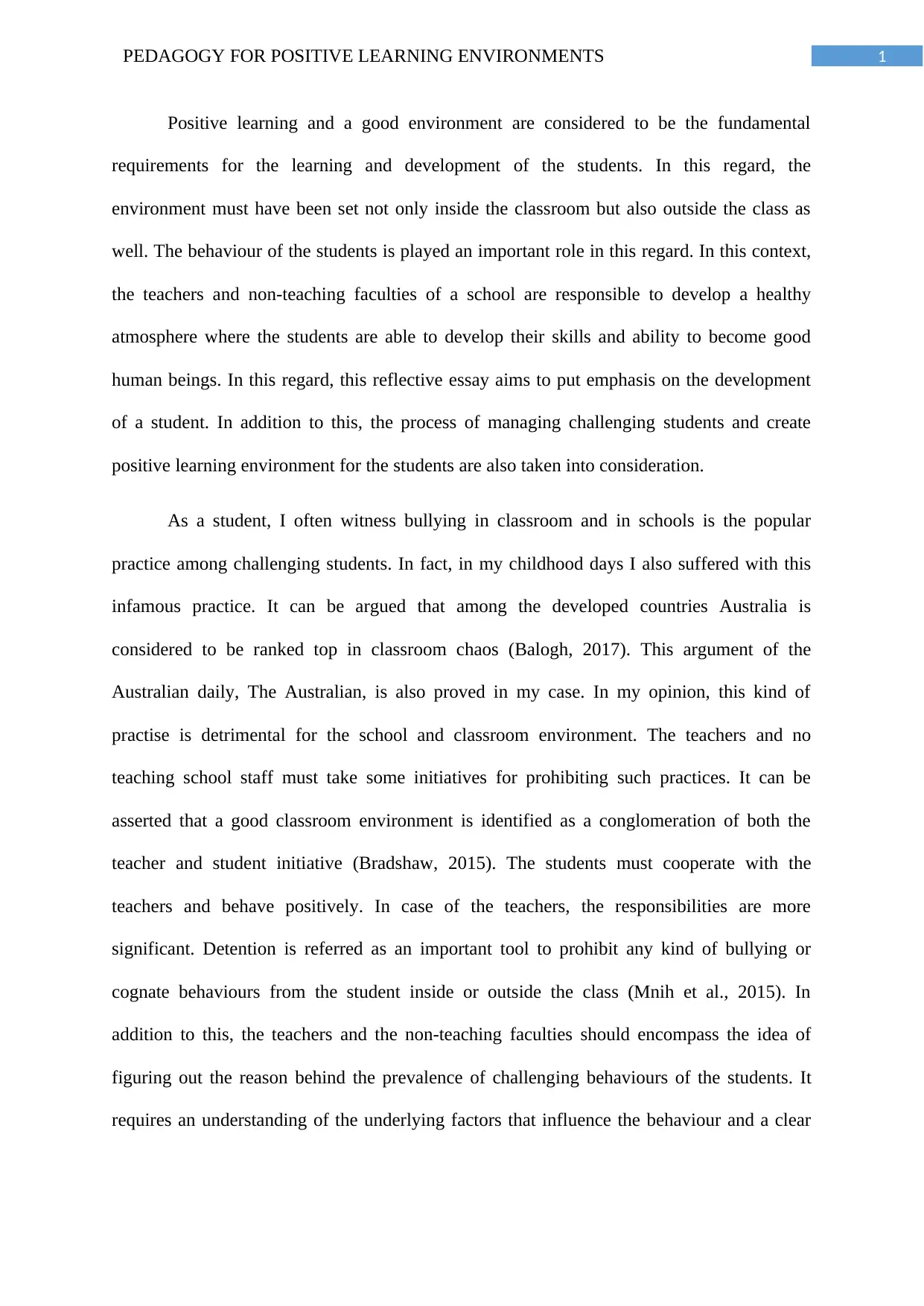
1PEDAGOGY FOR POSITIVE LEARNING ENVIRONMENTS
Positive learning and a good environment are considered to be the fundamental
requirements for the learning and development of the students. In this regard, the
environment must have been set not only inside the classroom but also outside the class as
well. The behaviour of the students is played an important role in this regard. In this context,
the teachers and non-teaching faculties of a school are responsible to develop a healthy
atmosphere where the students are able to develop their skills and ability to become good
human beings. In this regard, this reflective essay aims to put emphasis on the development
of a student. In addition to this, the process of managing challenging students and create
positive learning environment for the students are also taken into consideration.
As a student, I often witness bullying in classroom and in schools is the popular
practice among challenging students. In fact, in my childhood days I also suffered with this
infamous practice. It can be argued that among the developed countries Australia is
considered to be ranked top in classroom chaos (Balogh, 2017). This argument of the
Australian daily, The Australian, is also proved in my case. In my opinion, this kind of
practise is detrimental for the school and classroom environment. The teachers and no
teaching school staff must take some initiatives for prohibiting such practices. It can be
asserted that a good classroom environment is identified as a conglomeration of both the
teacher and student initiative (Bradshaw, 2015). The students must cooperate with the
teachers and behave positively. In case of the teachers, the responsibilities are more
significant. Detention is referred as an important tool to prohibit any kind of bullying or
cognate behaviours from the student inside or outside the class (Mnih et al., 2015). In
addition to this, the teachers and the non-teaching faculties should encompass the idea of
figuring out the reason behind the prevalence of challenging behaviours of the students. It
requires an understanding of the underlying factors that influence the behaviour and a clear
Positive learning and a good environment are considered to be the fundamental
requirements for the learning and development of the students. In this regard, the
environment must have been set not only inside the classroom but also outside the class as
well. The behaviour of the students is played an important role in this regard. In this context,
the teachers and non-teaching faculties of a school are responsible to develop a healthy
atmosphere where the students are able to develop their skills and ability to become good
human beings. In this regard, this reflective essay aims to put emphasis on the development
of a student. In addition to this, the process of managing challenging students and create
positive learning environment for the students are also taken into consideration.
As a student, I often witness bullying in classroom and in schools is the popular
practice among challenging students. In fact, in my childhood days I also suffered with this
infamous practice. It can be argued that among the developed countries Australia is
considered to be ranked top in classroom chaos (Balogh, 2017). This argument of the
Australian daily, The Australian, is also proved in my case. In my opinion, this kind of
practise is detrimental for the school and classroom environment. The teachers and no
teaching school staff must take some initiatives for prohibiting such practices. It can be
asserted that a good classroom environment is identified as a conglomeration of both the
teacher and student initiative (Bradshaw, 2015). The students must cooperate with the
teachers and behave positively. In case of the teachers, the responsibilities are more
significant. Detention is referred as an important tool to prohibit any kind of bullying or
cognate behaviours from the student inside or outside the class (Mnih et al., 2015). In
addition to this, the teachers and the non-teaching faculties should encompass the idea of
figuring out the reason behind the prevalence of challenging behaviours of the students. It
requires an understanding of the underlying factors that influence the behaviour and a clear
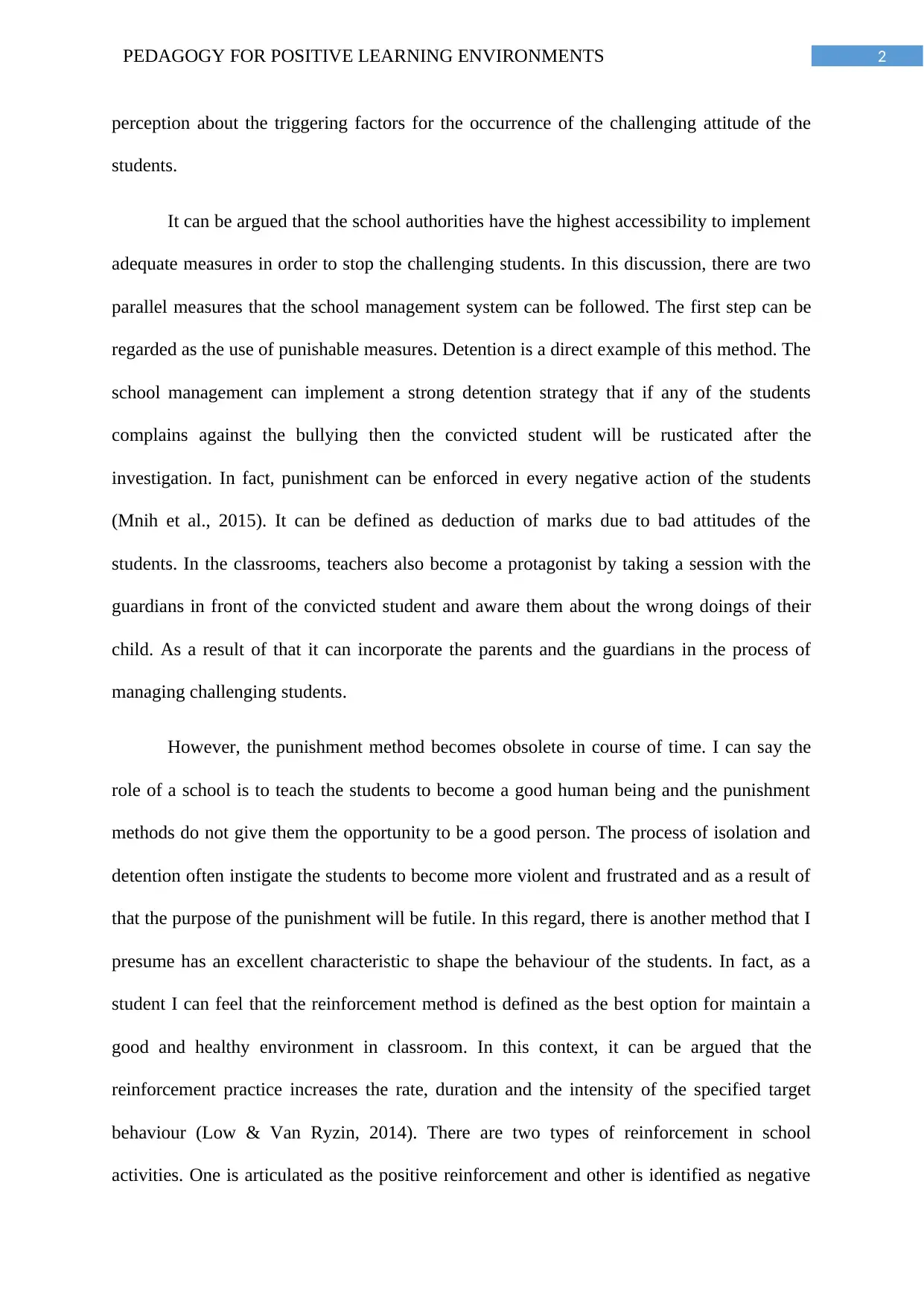
2PEDAGOGY FOR POSITIVE LEARNING ENVIRONMENTS
perception about the triggering factors for the occurrence of the challenging attitude of the
students.
It can be argued that the school authorities have the highest accessibility to implement
adequate measures in order to stop the challenging students. In this discussion, there are two
parallel measures that the school management system can be followed. The first step can be
regarded as the use of punishable measures. Detention is a direct example of this method. The
school management can implement a strong detention strategy that if any of the students
complains against the bullying then the convicted student will be rusticated after the
investigation. In fact, punishment can be enforced in every negative action of the students
(Mnih et al., 2015). It can be defined as deduction of marks due to bad attitudes of the
students. In the classrooms, teachers also become a protagonist by taking a session with the
guardians in front of the convicted student and aware them about the wrong doings of their
child. As a result of that it can incorporate the parents and the guardians in the process of
managing challenging students.
However, the punishment method becomes obsolete in course of time. I can say the
role of a school is to teach the students to become a good human being and the punishment
methods do not give them the opportunity to be a good person. The process of isolation and
detention often instigate the students to become more violent and frustrated and as a result of
that the purpose of the punishment will be futile. In this regard, there is another method that I
presume has an excellent characteristic to shape the behaviour of the students. In fact, as a
student I can feel that the reinforcement method is defined as the best option for maintain a
good and healthy environment in classroom. In this context, it can be argued that the
reinforcement practice increases the rate, duration and the intensity of the specified target
behaviour (Low & Van Ryzin, 2014). There are two types of reinforcement in school
activities. One is articulated as the positive reinforcement and other is identified as negative
perception about the triggering factors for the occurrence of the challenging attitude of the
students.
It can be argued that the school authorities have the highest accessibility to implement
adequate measures in order to stop the challenging students. In this discussion, there are two
parallel measures that the school management system can be followed. The first step can be
regarded as the use of punishable measures. Detention is a direct example of this method. The
school management can implement a strong detention strategy that if any of the students
complains against the bullying then the convicted student will be rusticated after the
investigation. In fact, punishment can be enforced in every negative action of the students
(Mnih et al., 2015). It can be defined as deduction of marks due to bad attitudes of the
students. In the classrooms, teachers also become a protagonist by taking a session with the
guardians in front of the convicted student and aware them about the wrong doings of their
child. As a result of that it can incorporate the parents and the guardians in the process of
managing challenging students.
However, the punishment method becomes obsolete in course of time. I can say the
role of a school is to teach the students to become a good human being and the punishment
methods do not give them the opportunity to be a good person. The process of isolation and
detention often instigate the students to become more violent and frustrated and as a result of
that the purpose of the punishment will be futile. In this regard, there is another method that I
presume has an excellent characteristic to shape the behaviour of the students. In fact, as a
student I can feel that the reinforcement method is defined as the best option for maintain a
good and healthy environment in classroom. In this context, it can be argued that the
reinforcement practice increases the rate, duration and the intensity of the specified target
behaviour (Low & Van Ryzin, 2014). There are two types of reinforcement in school
activities. One is articulated as the positive reinforcement and other is identified as negative
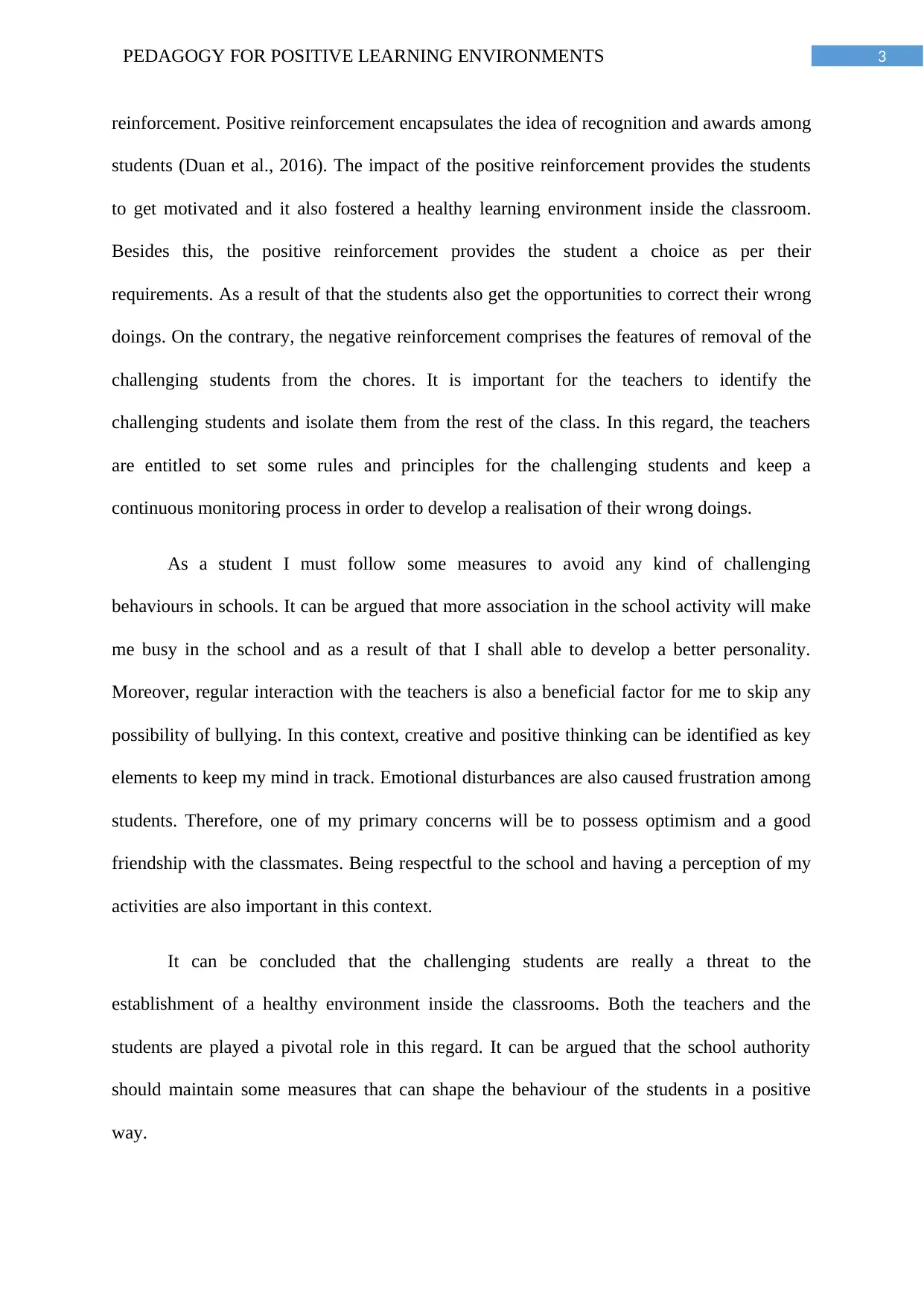
3PEDAGOGY FOR POSITIVE LEARNING ENVIRONMENTS
reinforcement. Positive reinforcement encapsulates the idea of recognition and awards among
students (Duan et al., 2016). The impact of the positive reinforcement provides the students
to get motivated and it also fostered a healthy learning environment inside the classroom.
Besides this, the positive reinforcement provides the student a choice as per their
requirements. As a result of that the students also get the opportunities to correct their wrong
doings. On the contrary, the negative reinforcement comprises the features of removal of the
challenging students from the chores. It is important for the teachers to identify the
challenging students and isolate them from the rest of the class. In this regard, the teachers
are entitled to set some rules and principles for the challenging students and keep a
continuous monitoring process in order to develop a realisation of their wrong doings.
As a student I must follow some measures to avoid any kind of challenging
behaviours in schools. It can be argued that more association in the school activity will make
me busy in the school and as a result of that I shall able to develop a better personality.
Moreover, regular interaction with the teachers is also a beneficial factor for me to skip any
possibility of bullying. In this context, creative and positive thinking can be identified as key
elements to keep my mind in track. Emotional disturbances are also caused frustration among
students. Therefore, one of my primary concerns will be to possess optimism and a good
friendship with the classmates. Being respectful to the school and having a perception of my
activities are also important in this context.
It can be concluded that the challenging students are really a threat to the
establishment of a healthy environment inside the classrooms. Both the teachers and the
students are played a pivotal role in this regard. It can be argued that the school authority
should maintain some measures that can shape the behaviour of the students in a positive
way.
reinforcement. Positive reinforcement encapsulates the idea of recognition and awards among
students (Duan et al., 2016). The impact of the positive reinforcement provides the students
to get motivated and it also fostered a healthy learning environment inside the classroom.
Besides this, the positive reinforcement provides the student a choice as per their
requirements. As a result of that the students also get the opportunities to correct their wrong
doings. On the contrary, the negative reinforcement comprises the features of removal of the
challenging students from the chores. It is important for the teachers to identify the
challenging students and isolate them from the rest of the class. In this regard, the teachers
are entitled to set some rules and principles for the challenging students and keep a
continuous monitoring process in order to develop a realisation of their wrong doings.
As a student I must follow some measures to avoid any kind of challenging
behaviours in schools. It can be argued that more association in the school activity will make
me busy in the school and as a result of that I shall able to develop a better personality.
Moreover, regular interaction with the teachers is also a beneficial factor for me to skip any
possibility of bullying. In this context, creative and positive thinking can be identified as key
elements to keep my mind in track. Emotional disturbances are also caused frustration among
students. Therefore, one of my primary concerns will be to possess optimism and a good
friendship with the classmates. Being respectful to the school and having a perception of my
activities are also important in this context.
It can be concluded that the challenging students are really a threat to the
establishment of a healthy environment inside the classrooms. Both the teachers and the
students are played a pivotal role in this regard. It can be argued that the school authority
should maintain some measures that can shape the behaviour of the students in a positive
way.
Secure Best Marks with AI Grader
Need help grading? Try our AI Grader for instant feedback on your assignments.
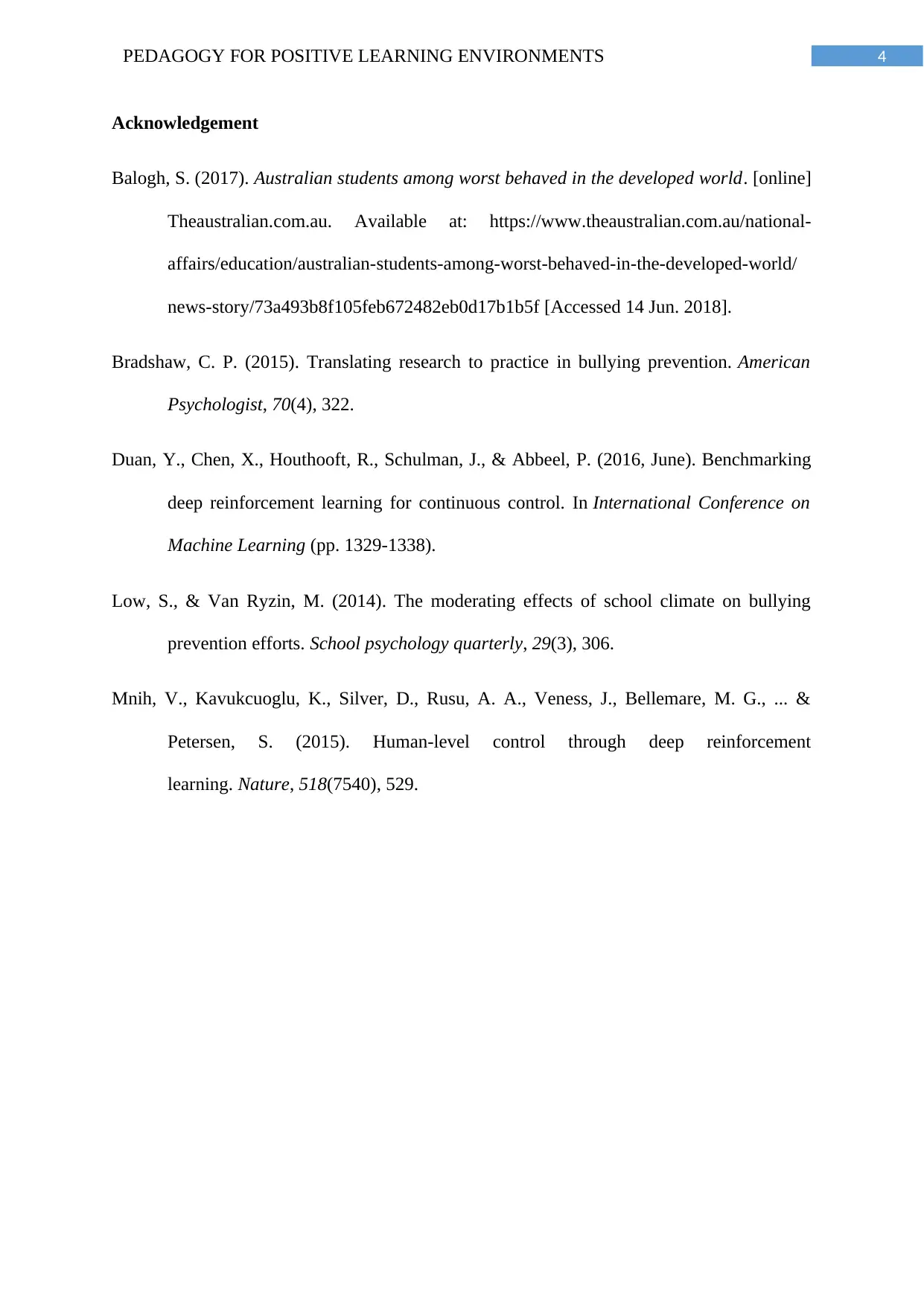
4PEDAGOGY FOR POSITIVE LEARNING ENVIRONMENTS
Acknowledgement
Balogh, S. (2017). Australian students among worst behaved in the developed world. [online]
Theaustralian.com.au. Available at: https://www.theaustralian.com.au/national-
affairs/education/australian-students-among-worst-behaved-in-the-developed-world/
news-story/73a493b8f105feb672482eb0d17b1b5f [Accessed 14 Jun. 2018].
Bradshaw, C. P. (2015). Translating research to practice in bullying prevention. American
Psychologist, 70(4), 322.
Duan, Y., Chen, X., Houthooft, R., Schulman, J., & Abbeel, P. (2016, June). Benchmarking
deep reinforcement learning for continuous control. In International Conference on
Machine Learning (pp. 1329-1338).
Low, S., & Van Ryzin, M. (2014). The moderating effects of school climate on bullying
prevention efforts. School psychology quarterly, 29(3), 306.
Mnih, V., Kavukcuoglu, K., Silver, D., Rusu, A. A., Veness, J., Bellemare, M. G., ... &
Petersen, S. (2015). Human-level control through deep reinforcement
learning. Nature, 518(7540), 529.
Acknowledgement
Balogh, S. (2017). Australian students among worst behaved in the developed world. [online]
Theaustralian.com.au. Available at: https://www.theaustralian.com.au/national-
affairs/education/australian-students-among-worst-behaved-in-the-developed-world/
news-story/73a493b8f105feb672482eb0d17b1b5f [Accessed 14 Jun. 2018].
Bradshaw, C. P. (2015). Translating research to practice in bullying prevention. American
Psychologist, 70(4), 322.
Duan, Y., Chen, X., Houthooft, R., Schulman, J., & Abbeel, P. (2016, June). Benchmarking
deep reinforcement learning for continuous control. In International Conference on
Machine Learning (pp. 1329-1338).
Low, S., & Van Ryzin, M. (2014). The moderating effects of school climate on bullying
prevention efforts. School psychology quarterly, 29(3), 306.
Mnih, V., Kavukcuoglu, K., Silver, D., Rusu, A. A., Veness, J., Bellemare, M. G., ... &
Petersen, S. (2015). Human-level control through deep reinforcement
learning. Nature, 518(7540), 529.
1 out of 5
Related Documents
Your All-in-One AI-Powered Toolkit for Academic Success.
+13062052269
info@desklib.com
Available 24*7 on WhatsApp / Email
![[object Object]](/_next/static/media/star-bottom.7253800d.svg)
Unlock your academic potential
© 2024 | Zucol Services PVT LTD | All rights reserved.





